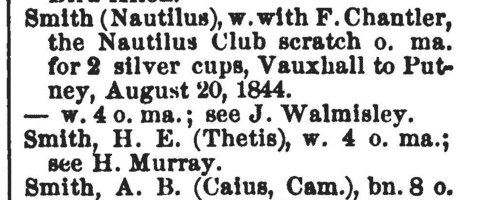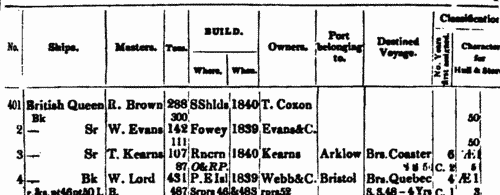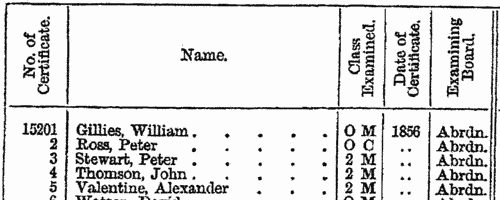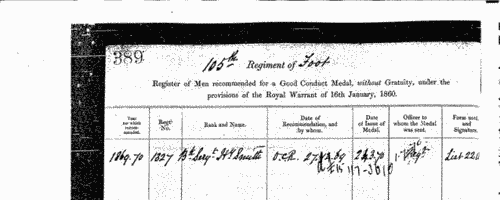Bulford Surname Ancestry ResultsOur indexes 1845-1865 include entries for the spelling 'bulford'. In the period you have requested, we have the following 10 records (displaying 1 to 10): Buy all | | | Get all 10 records to view, to save and print for £60.00 |
These sample scans are from the original record. You will get scans of the full pages or articles where the surname you searched for has been found. Your web browser may prevent the sample windows from opening; in this case please change your browser settings to allow pop-up windows from this site. Gentlemen amateur rowers
(1835-1851)
Rowing was one of the English sports covered in detail in the pages of Bell's Life in London, and from these was compiled a compendium called the Aquatic Oracle. The text is divided into two main parts: Gentlemen Amateurs and Watermen. All the entries are cross-referenced, and use these abbreviations: w., won; l., lost; b., beat; bn., beaten; sc. ma., scullers' match; o. ma., oars match; do. sc. ma., double scullers' match; 4 o.ma., 4 oars match; 8 o. ma., 8 oars match; sk., stroke; cox., coxswain; as., a side; Oxon., Oxonian; V. to P., Vauxhall to Putney; W. to P., Westminster to Putney; P. to M., Putney to Mortlake; M. to P., Mortlake to Putney; dis., distance.BULFORD. Cost: £6.00.  | Sample scan, click to enlarge

| Traders and professionals in London
(1851)
The Post Office London Directory for 1851 includes this 'Commercial and Professional Directory', recording about 80,000 individuals. BULFORD. Cost: £4.00.  | Sample scan, click to enlarge

| Masters of Merchantmen
(1852-1853)
Lloyd's Register of British and Foreign Shipping was issued annually, listing ships that had been surveyed preparatory to being insured. This is the register issued 1 July 1852 and then annotated as ships were re-surveyed through to 30 June 1853. The ships were numbered by the first letter of their name, and then by number alphabetically through the ships' names and within ships of the same name alphabetically by surname of the master. After the name of the ship there is the type of vessel (Bk, barque; Bg, brig; Bn, brigantine; Cr, cutter; Dr, dogger; G, galliott; H, hoy; K, ketch; Lr, lugger; Pol, polacre; S, ship; Sk, smack; Sp, sloop; Sr, schooner; St, schoot; Stm, steamer; Sw, snow; Yt, yacht), master's name (as at the time of the last survey); tonnage; place and year of build; owners; port belonging to; destined voyage; number of years first assigned; and character for hull and stores (e. g., A 1), with the year or month (e. g., 50 for 1850, or 2 for February 1852) of inspection. Underneath some entries details were given of construction and repair, with year - s., sheathed; d., doubled; C., coppered; I. B., iron bolts; c. f., copper fastened; M., sheathed with marine metal; Y. M., sheathed with yellow metal; G., sheathed with galvanised iron; Z., sheathed with zinc; F., felt; C. lm., coppered to light water or ballast mark; C. T., copper bolts substituted for treenails; Cl., clincher; len., lengthened; lrp., large repairs; trp., thorough repairs; Drp., damage repaired; ND., new deck; N TSds., new top-sides; W. C., wales cased; NW., new wales; NB., new bottom; NK., new keel; plk, Plank; N Klsn, new kelson; alm. rb., almost rebuilt; pt O. M., part old materials (timbers or plank); Srprs, some repairs - and, in italics, the timber of the ship is described - A, ash; B B, black birch; Bh, beech; C, cedar; E, elm; F, fir; G, gum; Ght, greenheart; Hk, hackmatack; Hm, hemlock; L, locust; Lh, larch; L O, live oak; M, mahogany; P, pine; P P, pitch pine; R P, red pine; Y P, yellow pine; S, spruce; T, teak; Tam, tamarac; W H, witch hazel; W O, white oak. The sample scan is from the main list. The third column, reserved for masters' names, is not particularly wide; with short surnames, an initial will be given; but longer surnames omit the initials, and even longer surnames are abbreviated. This is the index to masters in the main list. Often new masters had been appointed by the time of re-survey, and their names are added in slightly smaller type under the original master's names in the third column. These new masters are also included in this index. It should be borne in mind that the masters in the main list are those at the time of the respective previous survey for each ship, not necessarily as of 1 July 1852.BULFORD. Cost: £6.00.  | Sample scan, click to enlarge

| Traders and professionals in London
(1856)
The Post Office London Directory for 1856 includes this 'Commercial and Professional Directory', recording over 100,000 individuals. BULFORD. Cost: £4.00.  | Sample scan, click to enlarge

|  Persons of standing recommending London police recruits
(1843-1857) Persons of standing recommending London police recruits
(1843-1857)
The Metropolitan Police Register of Joiners (MEPO 4/334) lists policemen joining the force 1 January 1843 to 1 April 1857 (warrant numbers 19893 to 35804). The register is alphabetical, in so far as the recruits are listed chronologically grouped under first letter of surname. It gives Date of Appointment, Name, Number of Warrant, Cause of Removal from Force (resigned, dismissed, promoted or died), and Date of Removal. Although the register was closed for new entrants at the end of 1842, the details of removals were always recorded, some being twenty or more years later. Those recruits not formerly in the police, the army, or some government department, were required to provide (normally) at least two letters of recommendation from persons of standing, and details of these are entered on the facing pages. Where a recruit was only recently arrived in the metropolis, the names and addresses of the recommenders can be invaluable for tracing where he came from. Those recruits not formerly in the police, the army, or some government department, were required to provide (normally) at least two letters of recommendation from persons of standing, and details of these are entered on the facing pages: the names in these are indexed here (the police recruits are indexed separately and not included here). Recruits transferred from other forces or rejoining the force did not normally need recommendations - in the latter case, former warrant numbers are given - but some recommendations are from police inspectors, even other constables. Recruits coming from the army sometimes have general military certificates of good conduct, but most often have a letter from their former commanding officer; recruits recommended by government departments (most often the Home Office) similarly have letters from the head of department. But the great majority of the names and addresses in these pages are of respectable citizens having some sort of personal acquaintance with the recruit. Where more than two recommendations were provided, the clerk would only record one or two, with the words 'and others'. Tradesmen are sometimes identified as such by their occupations; there are some gentry. Although the bulk of these names are from London and the home counties, a scattering are from further afield throughout Britain and Ireland. BULFORD. Cost: £8.00.  | Sample scan, click to enlarge

| Masters and Mates of Merchantmen: Certificates of Competency
(1857)
The Mercantile Navy List and Annual Appendage to the Commercial Code of Signals for All Nations, edited by J. H. Brown, was published By Authority in 1857. It includes this full list of 'Masters and Mates who have passed their examination and obtained Certificates of Competency', from number 1 to number 15816, except for those whose certificates had been cancelled. The first column gives the number of certificate; the second column full name, surname first (an asterisk before the name denotes those who are found qualified to act in fore and aft-rigged vessels only; two vertical lines denotes in North Wales fishery only; a double dagger, passed the examination in steam; and a dagger refers to honorary testimonials, details of which are printed at the end of the section. A B C D are the distinguishing letters for the four classes of Meteorological Observers); third column, class examined (1 ex, 1, 2 and 3 denote First Extra, First, Second and Third Class Master's Certificate, granted under the Voluntary Examination, by Order in Council dated August 1845; Ex C, Master Extra; O C, Master Ordinary; 1 M, First Mate; O M, Only Mate; 2 M, Second Mate; L. R. N., Lieutenant Royal Navy; M. R. N., Master Royal Navy; E. I. C., East India Company; M. I. N., Master Indian Navy.); fourth column, year of certificate (where there are two dots, this is to represent a 'ditto' to the year next above); fifth column, Examining Board (Aberdeen, Belfast, Bristol, Cork, Dublin, Dundee, Glasgow, Greenock, Hull, Leith, Liverpool, London, Newcastle, Plymouth, Shields or Sunderland).BULFORD. Cost: £4.00.  | Sample scan, click to enlarge

|  Sailors and marines on board Her Majesty's ship Opossum
(1856-1860) Sailors and marines on board Her Majesty's ship Opossum
(1856-1860)
The China Medal was awarded to soldiers and sailors involved in the various actions of the war against China, in which this ship was engaged from 1856 to 1860. The medals were either delivered on board or sent on in 1862: except that many of the men were no longer immediately traceable, and the remarks on the roll show that some medals were not sent on for several years, and some were never sent. After the main roll there is a section showing which of the men also qualified for clasps. Separate clasps were awarded for men who had been in receipt of the China Medal of 1842; for the taking of Fatshan in 1857, Canton in 1857, Taku Forts in 1858, Taku Forts in 1860, and Pekin in 1860. Most of the men on this ship are shown as having been given the Fatshan clasp, for being actually present during the successful operations against the Chinese war junks in the Escapo creek, which commenced 25 May and were finally closed at Fatshan 1 June 1857; the Canton clasp, for being actually present at Canton on 28 and 29 December 1857, when that city was bombarded and finally captured; and the Taku Forts 1858 clasp, for being actually engaged in the operations which ceased with the first capture of the Taku Forts, 20 May 1858, and led to the Treaty of Tientsin.BULFORD. Cost: £8.00.  | Sample scan, click to enlarge

| Members of the Royal Agricultural Society of England
(1861)
The list of members of the Royal Agricultural Society gives names and addresses: life members are indicated by a dagger. (The names of 60 members were omitted on account of their subscriptions to the society being in arrear to 31 December 1859). This list is correct to June 1861; as of 11 December of that year there were 84 life governors, 95 annual governors, 1124 life members, 3399 annual members and 17 honorary members, making a total of 4719 names, mostly of landowners and agriculturists.BULFORD. Cost: £4.00.  | Sample scan, click to enlarge

|  Outstanding soldiers of the 65th regiment of Foot
(1860-1870) Outstanding soldiers of the 65th regiment of Foot
(1860-1870)
The 65th (The 2nd Yorkshire North Riding) Regiment of Foot embarked for New South Wales in 1846, and was moved directly from there to New Zealand. It returned to England in 1865, and to Ireland in 1867: the regimental depot was at Birr. Each year just a handful of outstanding soldiers of the regiment were chosen for good conduct medals and gratuities: these are listed here. There were two lists, one for men recommended for the Good Conduct Medal without a gratuity, and one for gratuities - £5 to a private, £10 to a corporal, and £15 to a serjeant. Both lists are indexed here, and each gives rank, name, regimental number, date of recommendation and date of issue. (The sample scan is from the 105th foot)BULFORD. Cost: £8.00.  | Sample scan, click to enlarge

|  Men of the 65th Regiment who fought in the New Zealand War
(1865-1870) Men of the 65th Regiment who fought in the New Zealand War
(1865-1870)
New Zealand War Medal roll for the 65th (2nd Yorkshire North Riding) Regiment of Foot: for service in the New Zealand campaign 1865 to 1867: the rolls were compiled following a general order in 1869 and the medals were distributed in 1870. The 1st battalion, serving in New South Wales, was moved to New Zealand in 1865; the men returned to England in 1867.BULFORD. Cost: £8.00.  | Sample scan, click to enlarge

|
Research your ancestry, family history, genealogy and one-name study by direct access to original records and archives indexed by surname.
|













